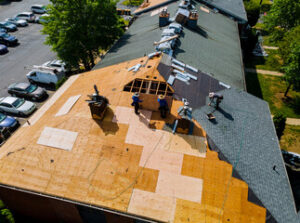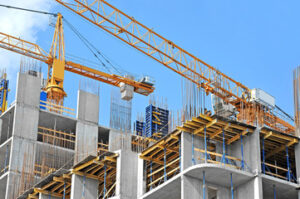A building’s roof protects against the elements and significantly influences its energy efficiency. It can also add to a property’s aesthetic value. Different types of Erie Roofing materials are suited to different climates and architectural styles.

The most recognizable element of a roof is its shingles. These come in a wide variety of colors and finishes. Sheathing, the base layer of a roof, consists of elongated wooden boards fastened to the rafters.
Sheathing is a structural layer installed between a home’s exterior cladding and its framing. It serves many functions, including providing a base for roofing materials and protecting the frame from moisture infiltration. The sheathing material you choose can directly impact the structure of your home and how it will perform over time. In addition, sheathing has an impact on insulation and energy efficiency, so it’s important to consider your options carefully when choosing a type of sheathing board.
Traditional plank sheathing is made from solid wood and features interlocking edges that fit together tightly to form a sturdy, durable surface. It is often used in older homes or for specific architectural styles that require a more classic look. Plank sheathing is typically more expensive than plywood or OSB, but it can add a beautiful aesthetic to any home. It’s also more labor-intensive to install, requiring more skilled carpenters to lay it out and nail it.
Plywood is a popular choice for roof sheathing, as it offers several key advantages. It’s strong enough to support the weight of roofing materials and resists warping under pressure or temperature changes. It also has a uniform surface that helps ensure a consistent base for the application of shingles and other roofing materials. Plywood is available in larger sheet sizes, making it easier to install and reducing labor costs. It’s also more resistant to moisture than other types of sheathing, making it a good choice for humid climates.
Oriented strand board, or OSB, is a common choice for wall sheathing in modern construction. It’s made from compressed wood strands bonded with adhesives, creating a strong and affordable option for new home construction. It’s also available in a variety of pre-cut panel sizes to reduce installation time. OSB is less expensive than plywood and has a lower environmental impact.
Although sheathing boards are a crucial component of any home, they can be easily damaged by harsh weather conditions or incorrect installation. If your sheathing is compromised, it’s important to contact a professional roofing contractor right away to avoid further damage and costly repairs. Signs of deteriorating sheathing include water stains on the ceiling or walls, sagging between rafters or joists, and fungal growth.
Sheet Sheathing
Sheathing is the fundamental base layer of your roof, providing structural support for shingles. It’s important to understand the different types of sheathing and how they perform, as this will help you make a smart decision when it comes time for a new roof or roof replacement. This guide will cover the basics of sheathing, including types, materials, and installation essentials.
Historically, property builders would run wooden boards perpendicular to the rafters and trusses. However, this system is not up to today’s building codes and will eventually result in gaps between the board that can be blown open by strong winds. For this reason, modern construction utilizes solid sheets of sheathing to create a stronger base for the roof. This sheathing is typically either 1/2’’ CDX plywood or 7/16’’ OSB (oriented strand board), and it can be purchased in 4×8 foot sheets. It’s crucial to use 3-inch nails when applying the sheathing in order to ensure a sturdy, secure hold.
Both plywood and OSB are popular choices for sheathing in wood-framed homes due to their uniformity and strength. They are also easier to install than traditional plank sheathing and provide a more stable foundation for the roof. Although these engineered wood products are common in residential construction, there are a variety of alternative options for specific projects and conditions. Exterior gypsum board and concrete sheathing are commonly used for nonstructural walls, while glass mat sheathing is a strong, moisture-resistant option for shear wall applications.
Plywood is ideal for garages, hobby rooms, and other indoor environments that require a durable surface. It’s also a better choice for damp basements, bathrooms, and other humid conditions where moisture damage is a concern. Gypsum board sheathing is a good alternative for nonstructural shear walls and is ideal for areas where fire resistance is a priority.
Glass mat sheathing has a gypsum core with an outer shell made of fiberglass, which makes it resistant to moisture and mold. It’s an excellent choice for shear walls, as well as for high-speed windy locations. It’s also becoming a common choice for green, eco-friendly buildings as it is a recyclable product.
Plywood
Plywood is a favorite among builders for constructing roof sheathing. It offers a wide range of advantages when used in roofing construction, including its durability and resistance to weathering. It is also lightweight, making it easier for roofs to support heavy loads and high winds. Plywood can be found in a variety of grades, each suited for specific uses. The differences between each grade can impact both the cost and durability of the material.
Plywood sheathing is made of layers of thin sheets of wood, or veneers, glued together. These layers are positioned at opposing wood-grain angles to each other, providing exceptional strength and stability. This layered design makes it more resistant to warping and other defects caused by natural wood movements. It is also treated with waterproof adhesives to resist moisture damage. This enhanced durability makes it an excellent choice for areas with high humidity or saltwater exposure.
In contrast, oriented strand board (OSB) is manufactured by binding strands of wood chips together. This material is less expensive than plywood, but it is prone to moisture damage and deformation over time. Its inferiority to plywood in this regard has led some builders to avoid using it in sheathing, preferring the more sturdy material of plywood instead.
The quality of a piece of plywood can vary greatly depending on the type of wood that is used and how it is treated. For example, Baltic birch plywood is known for its strength and durability due to its thick veneers and high number of plies. It is often used in construction applications that will leave the edges exposed, such as cabinetry and furniture.
Different types of plywood cores are also available to suit different needs. Veneer cores are the most common, and this is what most home improvement stores sell. They are suitable for most home building projects. Other types of cores include hardwood veneer plywood, which can be a good choice for high-end projects that demand the highest quality. Aircraft plywood is crafted to precise aerospace industry standards, striking a delicate balance between strength and weight.
Metal
The roofing material you choose will have a profound impact on the cost, aesthetics, performance, maintenance and durability of your home. Asphalt shingles, wood shakes, composite and concrete tiles are all viable roofing options, but when you’re looking for something unique and long-lasting, metal is the way to go.
Metal roofing has long been a popular choice for industrial buildings, but it’s become an increasingly desirable residential option as well. With its durable construction and vast color and style choices, it’s a popular alternative to traditional asphalt shingle roofs. In addition to its long lifespan, metal is a fire-resistant material that adds structural integrity to your home and can help reduce cooling costs.
There are many different types of metal used for roofing, but steel and aluminum remain the most common. Each has its own advantages and disadvantages, but both are highly effective at resisting corrosion and preventing water leaks. Steel is a strong and affordable material, while aluminum offers an excellent strength-to-weight ratio. Aluminum is also great for coastal homes because it can withstand sea salt spray without rusting.
Both steel and aluminum can be purchased with a mill finish or in a wide range of paint colors. If you choose a mill finish, your metal will oxidize naturally for a raw metal look that’s easy to maintain, while painted panels offer a 40- or 50-year paint warranty. If you’re concerned about rust, consider choosing galvanized or Galvalume steel—both are coated with a zinc and aluminum alloy to defy rust.
Another type of metal roof is a stone-coated one, which combines the timeless beauty of tile with the longevity of metal. These roofs are more expensive than other types of metal roofing but are known for their energy efficiency and resistance to moss, mold, hail and wind damage.




